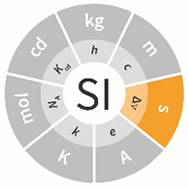Time (the second, s)
SI base unit of time
Current Definition
The second, symbol s, is the SI unit of time. It is defined by taking the fixed numerical value of the caesium frequency ΔvCs, the unperturbed ground-state hyperfine transition frequency of the caesium 133 atom, to be 9 192 631 770 when expressed in the unit Hz, which is equal to s−1.

History
| Year | Definition of the Second |
|---|---|
| Before 1960 | The second, was defined as the fraction 1/86 400 of the mean solar day. However, this turned out to be an unsatisfactory definition since the rotation of the earth was found to be irregular. |
| 1960 | A new definition for the second was adopted to make it more precise. The definition was given by the International Astronomical Union based on the tropical year 1900 as follows. "The second is the fraction 1/31 556 925.9747 of the tropical year for 1900 January 0 at 12 hours ephemeris time." |
| 1967 | Earlier experiments had shown that an atomic clock based on transition between energy levels of an atom gave much more accurate time. A new definition based on the ground state hyperfine transition in the caesium 133 atom was adopted. "The second is the duration of 9 192 631 770 periods of the radiation corresponding to the transition between the two hyperfine levels of the ground state of the caesium 133 atom." |
| 1997 | CIPM added "This definition refers to a caesium atom at rest at a temperature of 0 K." to the definition. This is to clarify that the definition of the SI second is based on a caesium atom unperturbed by black body radiation. |
| 2019 | The definition of the second, albeit unchanged, was re-phased as follows "The second, symbol s, is the SI unit of time. It is defined by taking the fixed numerical value of the caesium frequency ΔvCs, the unperturbed ground-state hyperfine transition frequency of the caesium 133 atom, to be 9 192 631 770 when expressed in the unit Hz, which is equal to s−1." |
Reference
- The International System of Units (SI) – Base Unit
- The ninth SI Brochure.